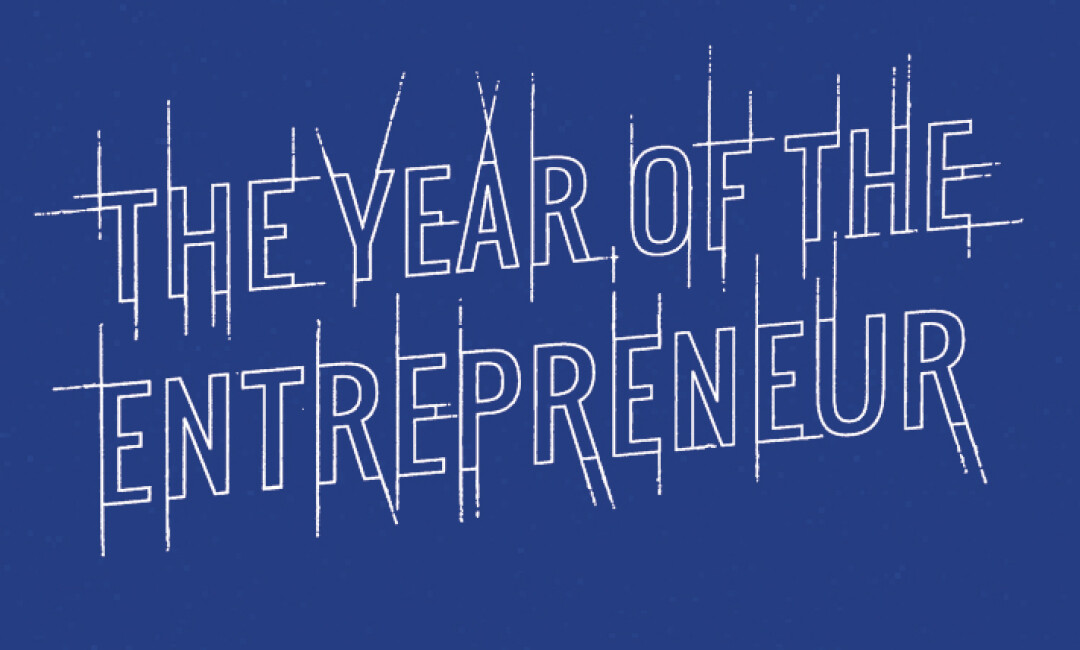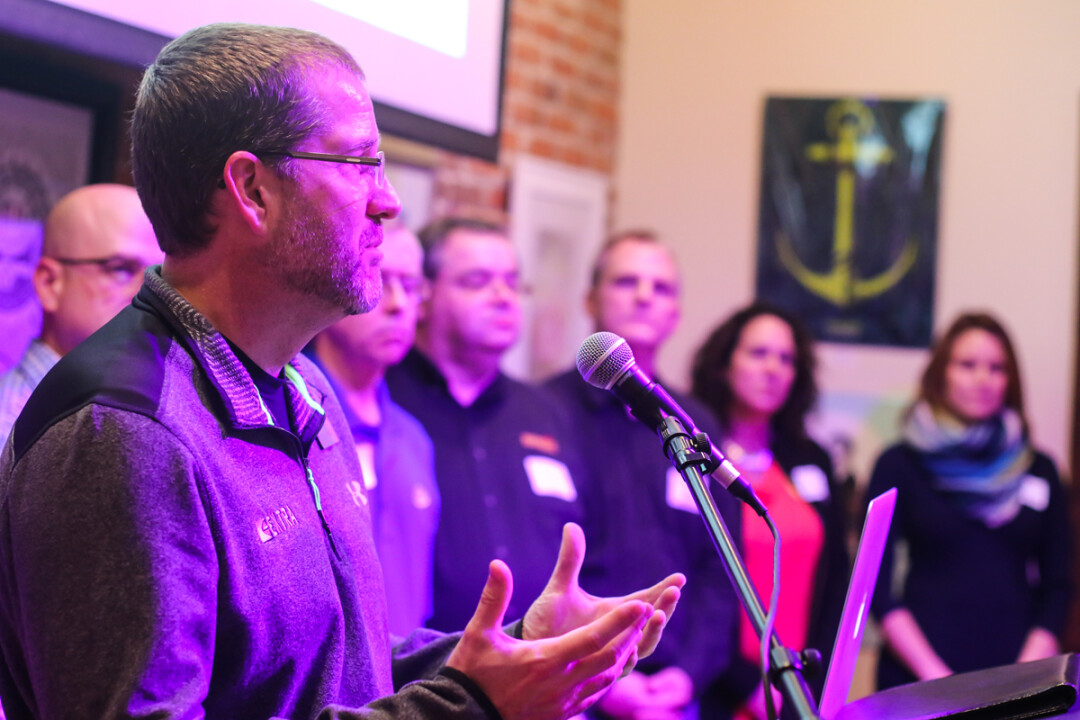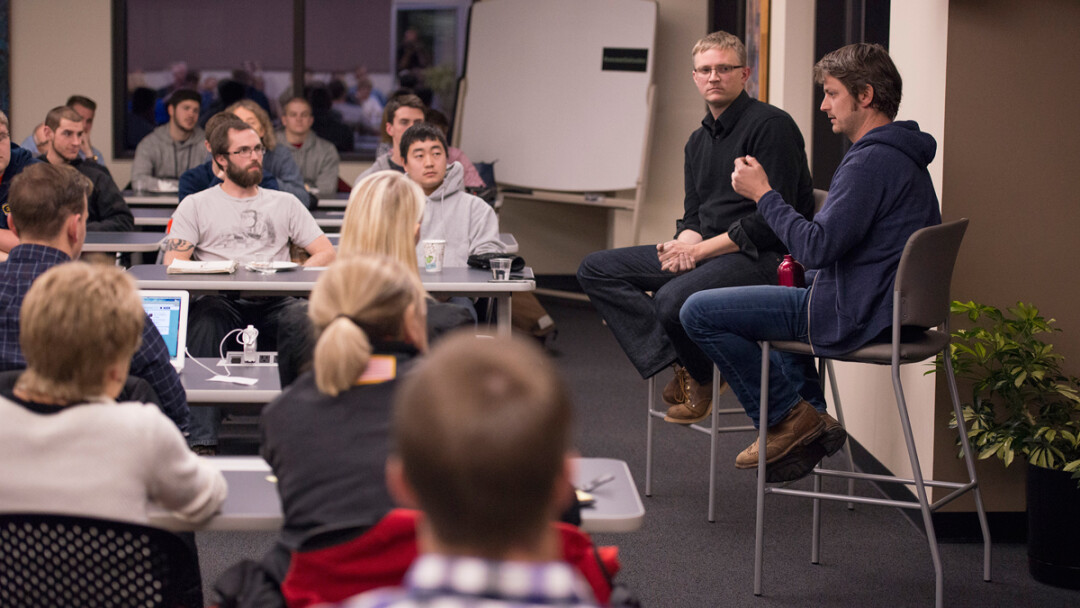The Year of the Entrepreneur
an increasing focus on startup businesses in the Chippewa Valley is paying dividends, observers say, with more people taking the risky but thrilling leap into entrepreneurship
Tom Giffey, photos by Andrea Paulseth |
Related Editor's Note: Supporting the Impulse of Our Idea People

Pivotal years and critical events are often only recognizable in retrospect. Trends are usually hard to spot when we are in the midst of them. And yet, even keeping such cautious Midwestern wisdom in mind, it’s clear that something has shifted in the Chippewa Valley. From new corner stores to globally recognized innovators, our once-sleepy Wisconsin enclave is alive with entrepreneurial energy. Local businesses, agencies, and educational institutions are working together to stoke the fire. Success is breeding success, and stick-in-the-mud complacency is making way for millennial creativity. For business creators, their employees, and the community at large, green shoots are in abundance even as winter arrives.
It’s difficult to point to any one thing that has made 2015 the Year of the Entrepreneur in the Chippewa Valley – and that’s probably as it should be. Overdependence on any single individual, business, or industry is economically dangerous (consider the devastation wrought when Eau Claire’s Uniroyal Goodrich Tire Co. plant closed in 1992), while a healthy economy is a diverse one. The launching, strengthening, and refashioning of various entrepreneurial initiatives over the past year have contributed to the region’s momentum. In the span of just a couple of months this fall, for instance, the inaugural Eau Claire Startup Weekend was held, followed by UW-Eau Claire’s first-ever Entrepreneur Week; a new website to promote entrepreneurship, Startup Current, was unveiled; the Innovation Foundation of Western Wisconsin was rebranded as Ignite Wisconsin, with a new focus and a new mission; the ribbon was cut on an improved Chippewa Valley Innovation Center; the Eau Claire Area Economic Development Corp. and the UW-Eau Claire Small Business Development Center relocated to a joint office; and Eau Claire’s poster child for economic innovation, JAMF Software, passed the 500-employee mark. And that’s just the tip of the entrepreneurial iceberg.

NUMBERS RISING
“When you’re walking away from a job where you have a regular paycheck, you need a lot of encouragement,” says Scott Biederman – but that’s just what he did last year when left his job as a plant manager with Phillips Plastics, for whom he’d worked for more than 15 years, to forge out on his own. The Chippewa Falls man started a business, Profitable Transitions, to provide consulting and management to companies and departments in the midst of turnarounds. Biederman realized taking the leap was risky – but he also realized that he had skills that could help other businesses survive and grow. “I wanted to send a message to my kids that it’s more important to be a person of value than a person of success,” Biederman says. However, he has found success in his new project, helping entrepreneurs turn around their businesses. He’s also become a partner in another venture, Future Farm US, an aquaponics business in Baldwin that raises fish and plants in a symbiotic environment.
“When you’re walking away from a job where you have a regular paycheck, you need a lot of encouragement.” – Scott Biederman, entrepreneur, Profitable Transitions
Biederman says western Wisconsin is a good place to create a business in part because of the resources available to entrepreneurs, including government agencies, community leaders, universities, and other organizations. “There’s a lot of help, and a lot of people working to give you a hand,” he says.
Those who work to give a hand to entrepreneurs like Biederman acknowledge that quantifying new business activity is almost as challenging as starting a new business. Nonetheless, there’s broad agreement that entrepreneurship is on the upswing.
“We’ve having more people get out there and take risks,” says Luke Hanson, executive director of the Eau Claire Area Economic Development Corp., a coalition of public and private partners focused on boosting the county’s economy.
Such agencies work to encourage entrepreneurs to take risks – calculated risks – something that’s not necessarily in the Midwestern DNA.
“We’ve been trying to build a culture that says giving something a try and it not working is not a failure, it’s a learning experience,” agrees Mike Schatz, economic development administrator for the City of Eau Claire. “There’s more knowledge of people who are serial entrepreneurs whose first idea didn’t make it.”
Available data bears out the impression that more businesses are starting. Statewide, nearly 36,000 domestic businesses were created in 2014, a roughly six percent increase over the previous year; year-to-date figures for 2015 also show growth. While comparable local figures aren’t available, agencies that provide assistance to new businesses have seen rising demand for their services.
With one month to go in 2015, the Small Business Development Center at UW-Eau Claire has already worked with more clients and helped with more business startups than in all of 2014, director Luke Kempen says. In addition, the center’s clients have received capital investment of $16.6 million this year, more than double last year’s figure, he says. Other statistics point to steady growth as well. According to the UW-Extension Division for Business and Entrepreneurship, the total number of business establishments in the Eau Claire metro grew by 3.3 percent between 2003 and 2013. While that may not seem like much, it’s important to note that those years straddle the Great Recession. In addition, the local figure exceeds both the state and national growth rates.

A LITTLE HELP FROM MY FRIENDS
The boost in entrepreneurship can be attributed to several factors. First, more local resources are available to startups than every before. Second, economic development agencies are focused on attracting future entrepreneurs, not just established businesses.
In the Chippewa Valley there are government- and university-affiliated economic development agencies, private investment groups, and numerous other entities whose mission is to boost businesses – typically small, startup businesses.
“I believe there are more opportunities for entrepreneurs to receive assistance and access to additional programs than maybe in years past,” says Schatz of the City of Eau Claire. “I think this trend started a few years back when there were so many company layoffs in corporate America, and people started reflecting on whether they wanted their destiny in the hands of a larger employer or if they wanted to benefit from their own hard work and the long hours they put in.”
The attitude of economic development entities has also changed. At one time, they focused on “chasing smokestacks” – luring large businesses, particularly manufacturers, with tax incentives and other deals. However, several factors have worked against this strategy. First, tight budgets make it harder to offer lucrative incentives to businesses. Second, there’s been a shift in thinking among economic development agencies toward fostering homegrown talent.
“If you can create five (jobs) here and five here and five here and five here, that’s sometimes easier than finding someone who employs 20 people,” explains Bob McCoy, CEO of the Eau Claire Area Chamber of Commerce. In order to encourage such new businesses, the Chamber of Commerce plans soon to create a new program for entrepreneurs, McCoy says.
There’s also less smokestack chasing now because of outsourcing: There are simply fewer smokestacks to chase in the United States. Today, encouraging startups is more likely to lead to results. “We value entrepreneurs, especially local ones, because we know they’re already committed to a community,” Schatz says. “It’s an easier sell because they’d really like to stay here.”Contemporary trends have also led to a focus on attracting desirable workers, not just businesses. Schatz notes that Millennials are more likely to pick a place they want to live before they pick a job. Because of that, economic development officials are more focused than before on fostering amenities – from bike trails to thriving music and arts scenes – that attract such individuals, he says. “We’re not just after companies to move here or stay here,” he says. “We’re after people.”
A newly formed group called the Chippewa Valley High-Tech Alliance has a similar goal. More than a dozen local high-tech firms have banded together to promote their collective interests and to market the region as a tech hub, particularly for those pursuing careers in the field.
“The alliance is really about creating a buzz and highlighting the Chippewa Valley as a high-technology hotbed,” Jim Ward, president of Applied Data Consultants Inc., said at a November press conference promoting the group. One of the ultimate goals is to promote the Chippewa Valley as the place to be for talented workers. While the members of the coalition don’t generally compete against each other in the same industries, they do complete with each other for employees, so their collaboration may seem counterintuitive. However, Ward maintains that attracting more talented workers to the region is good for all the coalitions members. “We can continue to fight over the limited talent here, or we can work together to increase the size of the pool,” he says.

WORKING TOGETHER
The world of business is awash in acronyms, as is the world of business assistance.
“There’s so many programs out there, it’ll make your head spin,” acknowledges Kempen, of the Small Business Development Center. That’s one of the reasons agencies that serve entrepreneurs are collaborating and coordinating more. In November, for example, the Eau Claire County Economic Development Corp. moved into new offices on South Dewey Street, where it was joined by the Small Business Development Center. Eventually, the EDC hopes to attract other economic development agencies to the office, creating a service hub for entrepreneurial clients.
Such co-location is just one example of how agencies are collaborating. In October, EDC staffers joined representatives of other groups as well as some successful entrepreneurs to launch a local incarnation of Startup Weekend, during which participants listened to lightning-fast business pitches, formed teams, and raced to get the entrepreneurial ideas off the ground in just 48 hours. The inaugural Eau Claire Startup Weekend had 11 participants, and there are plans to make the event bigger and better next year.
The EDC is working to create a business accelerator program, which would take a Startup Weekend-style approach but turn it into a six-month course that would help multiple startup businesses launch themselves. To do so, the EDC is hoping to obtain an appropriate co-working space.
And since the 1990s, the EDC has sponsored the Idea Challenge – originally known as the Create Your Own Business Contest – which awards prizes to local entrepreneurs based upon their innovative ideas. While the number of applicants to the Idea Challenge was down a bit this year, “The quality has gone up and we’re able to provide more targeted assistance to these people to expand their ideas,” says Patrick Gaetjens, the EDC’s program manager.
It’s important to note that collaboration isn’t exactly new. Since 1986, the Eau Claire County EDC and its Chippewa County equivalent – as well as representatives from numerous local businesses and agencies – have been partners in the Chippewa Valley Innovation Center, 3132 Louis Ave., which provides low-cost space to early-stage businesses. Over the years, numerous manufacturing and service businesses have grown out of the CVIC, and in September, renovations to the facility – including an upgraded loading dock and new offices – were unveiled.
Among the current Innovation Center tenants is Eco Urban Timber, a startup created by Julie McFadden of Menomonie. The business turns trees felled in the city of Eau Claire and elsewhere into handcrafted wood products ranging from laptop stands to wine racks. After developing her business idea, McFadden says she hunted high and low for assistance, from the Eau Claire Area Chamber of Commerce to UW-Extension classes to Western Dairyland. Eventually, she obtained funding through the Wisconsin Women’s Business Initiative Corp. in Milwaukee.
“There’s a good environment for generating ideas (in the Chippewa Valley). The challenge is that next step, which is the capital requirement step.” - Julie McFadden entrepreneur, Eco Urban Timber
In the Chippewa Valley, McFadden says, “There’s a good environment for generating ideas. The challenge is that next step, which is the capital requirement step. I think there’s a lot of ideas in the Chippewa Valley … but it’s (a matter of) having that solid business plan and being able to take that to the bank.”
EDUCATIONAL ENCOURAGEMENT
Educational institutions are also playing a role in encouraging entrepreneurship. Currently, there are about 75 students in the Dennis L. Heyde Entrepreneur Program in the UW-Eau Claire College of Business. Students can pursue a management degree with an emphasis in entrepreneurship or earn a minor in entrepreneurship. Most recently, a certificate of entrepreneurship was created, which is open to all UWEC students, whether or not they are enrolled in the College of Business.
The Entrepreneur Program is making other efforts to reach beyond the walls of the business school. In October, it sponsored the university’s first-ever Entrepreneur Week, which featured a series of presentations and social events intended to help fortify the region’s startup culture, specifically by engaging community members with the university. “When you create spaces and opportunities, you can’t predict what’s going to happen,” says Ann Rupnow, UWEC’s entrepreneurship and economic development coordinator.
Rupnow says the university works with other agencies – such as the city’s Economic Development Division and the EDC – to help create a flourishing entrepreneurial environment. The Entrepreneur Program also has partnered with Volume One to give students and faculty access to WorkSpace, a shared co-working facility at the Volume One office, 205 N. Barstow St.
In addition to such collaborations, Rupnow says the Entrepreneur Program was looking for an unfilled gap and struck upon the idea of creating a website that would be a clearinghouse of Chippewa Valley-specific entrepreneurial information. To that end, the newly launched Startup Current (startupcurrent.org) is meant “to promote a culture of entrepreneurship across our campus and throughout Eau Claire.” Specifically, the website features entrepreneurial news, event listings, and other resources.
UWEC and the College of Business are ready and willing to boost the state’s entrepreneurial standing, Rupnow says. “We need to be doing something,” she explains. “We have students and people who are eager to be entrepreneurs, so why not help them help our economy at the same time?”

FIRING THINGS UP
While numerous observers believe the Chippewa Valley has turned a corner when it comes to entrepreneurship, not everyone paints such a rosy picture. Not long after he took the helm of the Innovation Foundation of Western Wisconsin in 2013, Mike Finger, a serial entrepreneur himself, noticed something odd. While the nonprofit agency had a good track record of assisting start-up companies in the region, there was a surprising lack of demand for its services. “I’d open my door and look for the line, and I didn’t see it,” Finger explains. He began to delve into the statistics about entrepreneurship in Wisconsin and learned that the state ranked near the bottom – or even dead last – on many measurements of startup activity. According to the nonprofit Kauffman Foundation, for instance, Wisconsin is 50th among the states.
When Finger began asking people why Wisconsin ranked so poorly in business-creation rankings, “Culture is the only answer that resonated,” he says.
“We’re really good at coming up with reasons not to start a business,” Finger says. Prospective entrepreneurs can always cite such reasons: They’re too old. They’re too young. They’re economically disadvantaged. They’re at-home parents. They’re too busy. Too often, these are excuses not to act on a dream. “If that were a legitimate deterrent,” he says of this plethora of excuses, “no business would ever start.”
Something, Finger decided, had to change.
In the past, the Innovation Foundation focused on helping startup and growth businesses start and grow faster by connecting them with talented people – such as experienced business owners – who could help them break down specific barriers. Now, the organization’s mission is to encourage more potential entrepreneurs – or “wantrepreneurs” – to make the leap and actually start their own businesses. To that end, the Innovation Foundation has been transformed and rebranded as Ignite Wisconsin. The group’s goal is to offer “encouragement, inspiration, and connection” to would-be entrepreneurs and to link them with experienced entrepreneurial mentors. Among other things, Ignite Wisconsin is helping tell regional entrepreneurs’ stories through videos on its website and connecting them through monthly social events around the region.
“It’s time to step back from the short-term, job count obsession and start talking more (even obsessively) about how Wisconsin can encourage more new entrepreneurs to create more new businesses.” - Mike Finger, executive director, Ignite Wisconsin
Ultimately, Finger hopes that such interactions lead to more businesses and a healthier economy for the state. He argues that the number of new businesses created, rather than short-term job figures, should be the metric that policymakers focus on. As he contended in a column published Oct. 3 in the Wisconsin State Journal, start-ups end up creating the most jobs. He compares merely tallying jobs to counting apples, whereas encouraging business creation is akin to planting apple trees. “It’s time to step back from the short-term, job count obsession and start talking more (even obsessively) about how Wisconsin can encourage more new entrepreneurs to create more new businesses,” he wrote.

FINDING FUNDING
Sam Zordich, founder and CEO of RAI Stone Group, which creates financial analysis software, has done business on the East and West coasts as well as her native Midwest. Based upon this experience, her assessment of the Chippewa Valley’s entrepreneurial climate is mixed. On one hand, she says, there’s a strong – and increasing – level of support for startups from educational institutions, economic development agencies, and local governments. The region also offers a high quality of life and is full of good people, she says.
On the other hand, second-stage companies – those that have moved beyond the startup phase but aren’t yet fully established – can find little support, Zordich says. “If you’re a startup you’re golden, and if you’re a mature or existing company you’re golden,” she says. “If you’re in-between, you’re nothing.”
Perhaps, she says, this is due to the fabled Midwestern self-sufficiency. “As Midwesterners we tend to rely heavily on ourselves and not reach out,” she says. “But the reality is we’re working our buns off.” Around here, complaining about business challenges is typically perceived as whining, she adds. Elsewhere, especially on the coasts, she notes, struggling companies are more likely to get outside assistance, whether it’s in the form of a capital investment, a merger, or simply other businesses interested in buying a failing firm’s assets.
Venture capitalists or angel investors often fill such financial gaps for young firms. And while more of this kind of money is being invested in Wisconsin businesses than in the past – $87 million last year, according to the National Venture Capital Association – the state could still do better. Wisconsin ranks 27th, compared with 14th-ranked Minnesota, which saw more than four times as much venture capital investment in 2014.
In western Wisconsin, the Chippewa Valley Angel Investors Network is a major conduit for such investment. Executive director Pete Marsnik says the network, which is made up of high-net-worth individuals who want to buy stakes in early stage companies, typically makes investments of between $200,000 and $300,000. Marsnik and a partner also have a new venture, dubbed Musky Tank, aimed at investing in and providing services for startups. (Think of it as an Upper Midwest Shark Tank, but without the TV cameras.)
Marsnik’s assessment of the Valley’s startup culture is nuanced. On one hand, he says, entrepreneurs here often need more help honing their business plans than their counterparts elsewhere might. He attributes this to the fact that the region has fewer serial entrepreneurs who’ve been through the process before.
However, Marsnik also feels a change in the startup climate. “My sense is that the numbers are up, and that there are a lot of things happening,” he says. Some of this may be due to the example provided by a new crop of high-profile entrepreneurs, such as JAMF Software founder and Eau Claire native Zach Halmstad, whose company moved into a newly built office building next to Phoenix Park in downtown Eau Claire in late 2014.
“Among the things to happen are having more networking events and more contact of ideas with the people that can make them happen and having more successful entrepreneurs engaged in the community, the way Zach and Jim Ward (of Applied Data Consultants) and Jerry Bauer (of JB Systems) were involved in the Startup Weekend,” Marsnik says.
Then again, he adds, these entrepreneurs are hardly the first of their kind. In previous decades, the likes of supercomputer pioneer Seymour Cray and home improvement retailer John Menard created major businesses in the Chippewa Valley. “There is a culture of innovation and entrepreneurship in this region that is strong,” Marsnik notes.

SUSTAINING MOMENTUM
While there are inevitable ebbs and flows to the business cycle, observers are hopeful that current entrepreneurial trends in the Chippewa Valley can continue.
While the state may lag in the total number of startup firms, those numbers don’t tell the whole story. Midwesterners tend to be more risk-averse than people on the East or West coasts, but that’s not necessarily a bad thing, notes Gaetjens, the EDC program manager, who previously worked in economic development in New York City. While there may be more money chasing after projects in other places, Midwestern businesses tend to be more stable, he says, noting that entrepreneurs here are more likely to invest their own time and money into projects. When you put your house up for collateral on a business, he says, you tend to be more fully invested in the startup’s survival.
And Wisconsin firms are more likely to survive than those in most other states. In fact, Wisconsin ranked sixth in the nation in terms of business created in 2002 that lasted as least a decade, according to the U.S. Small Business Administration. Roughly 41 percent of Wisconsin firms founded in 2002 lasted through 2012, compared with just 29 percent in bottom-ranked Florida.
While Wisconsin’s business culture remains in many ways conservative – which may preclude businesses from looking for help – startups shouldn’t fear seeking out advice and assistance, says Biederman, the plastics plant manager-turned-entrepreneur. “The entrepreneur doesn’t need to feel like they need to know everything,” he says. “There are plenty of people who are out there who are good at the things that you are not good at.”
However, he adds, the culture in the Chippewa Valley seems to be changing, with more people willing to take risks because of the success of businesses such as JAMF. Overall growth in the region – including in downtown Eau Claire and the new River Prairie development along U.S. 53 in Altoona – is also an inspiration to businesses. “I’m really excited about what the future holds here,” Biederman says.
STARTUP STATISTICS
CHIPPEWA VALLEY
Local statistics on entrepreneurial activity are scarce, but those that are available indicate the Chippewa Valley’s startup scene is growing.
55%
Increase (from 110 to 171) in the annual number of clients worked with by the Small Business Development Center at UW-Eau Claire between 2012 and 2015. (The 2015 figures are through the end of November, so the year-end figure will be even higher.)
148%
Increase (from 25 to 62) in the number of jobs created by those clients between 2012 and 2015.
253%
Increase (from $4.7 million to $16.6 million) in the amount of capital infusion by those clients between 2012 and 2015.
3.3%
Increase in the total number of business establishments in the Eau Claire metro area between 2003 and 2013, a period that spans the Great Recession. This exceeds both the state (2.1%) and national (2.9%) growth rate.
STATEWIDE
Depending on which statistics you consider most important, characterizing Wisconsin’s startup scene isn’t just a glass half full vs. glass half empty proposition; it’s a matter of comparing an empty glass with one that’s nearly overflowing. Consider these figures.
Our startups survive...
6th
Wisconsin’s ranking among the states in terms business survival between 2002 and 2012, according to the U.S. Small Business Administration. Wisconsin outranked all other Midwestern states except North and South Dakota, which were No. 1 and No. 2, respectively.
40.9%
The share of Wisconsin establishments founded in 2002 that were still in business 10 years later, according to the U.S. Small Business Administration. By contrast, only 28.9% of new businesses survived for a decade in bottom-ranked Florida.
31,269
The number of new domestic businesses entities formed in Wisconsin in the first 10 months of 2015. That’s a 2.4% increase over the same period the previous year and a 27% increase from the same period in 2010.
...but we have fewer of them
50th
Wisconsin’s ranking among the states on the 2015 Kauffman Index of Startup Activity. The index is based upon state-by-state measurements of the rate of new entrepreneurs, the share of those entrepreneurs who were previously unemployed, and the density of startup firms.
-5
Wisconsin’s ranking among the states on the 2015 Kauffman Index of Startup Activity. The index is based upon state-by-state measurements of the rate of new entrepreneurs, the share of those entrepreneurs who were previously unemployed, and the density of startup firms.
170 per 100,000
The share of adults in Wisconsin who become entrepreneurs in a given month, tied with Minnesota for the lowest in the nation, according to the Kauffman Index. By contrast, 540 of every 100,000 Montana adults become entrepreneurs each month, putting that state atop the rankings.























